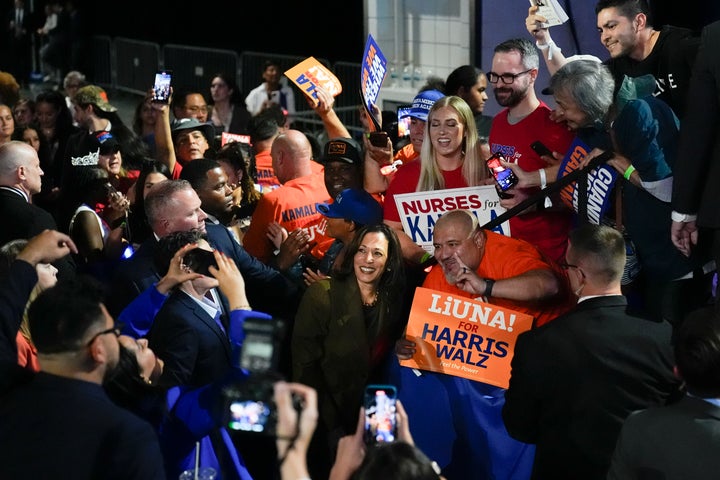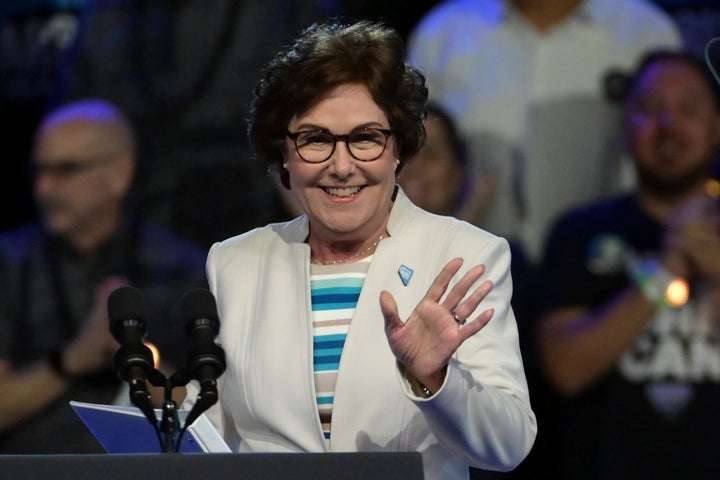
LAS VEGAS – Visiting Nevada for the second time since locking up the Democratic presidential nomination, Vice President Kamala Harris rallied over 7,500 supporters at a convention center in Las Vegas on Sunday evening, hoping to solidify her standing in a state where she leads former President Donald Trump by less than two percentage points.
In Nevada, a state Harris can ill afford to lose, concerns about the economy are at the forefront of voters’ minds. The Battle Born State’s dependence on tourism and the service-sector jobs it supports made it especially vulnerable to disruptions during the COVID-19 pandemic – disruptions it is still struggling to overcome.
Accordingly, after extending her “thoughts and prayers” to the victims of Hurricane Helene in Florida, Georgia and North Carolina, Harris spent a significant chunk of her half-hour remarks outlining her plans to create an “opportunity economy.”
“I pledge to you as president, I will fight for all Americans,” Harris declared. “And together, we will build a future that includes thinking about our economy in a way that is about lifting everyone up.”
She went on to outline the economic proposals she has rolled out in recent weeks. Those plans include increasing the startup tax credit for small business from $5,000 to $50,000; encouraging the construction of 3 million new homes and giving first-time home buyers $25,000 in help with a down payment; providing a $6,000 tax credit to parents of newborns; opening up a host of federal government jobs to people without college degrees; and cracking down on corporate “price gouging.” Harris chose to omit her plan not to tax service-sector workers’ tips, which she rolled out shortly after Trump proposed it.

Pivoting to Trump, she focused on the former president’s plans to cut taxes for the rich and raise middle-class taxes through a 20% tariff on all imports that she says will be passed onto consumers, while contrasting her middle-class upbringing with his privileged background. She also attributed to Trump a host of ideas that the former president has not explicitly endorsed, such as cutting Social Security and Medicare, but are in Project 2025, a right-wing policy template drafted by influential conservatives with ties to Trump.
“It is a detailed and dangerous blueprint for what he would do if he were elected again as president,” Harris said, asking attendees to “just Google it.”
The rally, which had signs in both English and Spanish, was a show of force just two weeks after Trump drew what his campaign estimated were over 6,000 attendees at the same convention center.
But Harris’ first rally in early August drew more than 14,000 people, suggesting there has been somewhat of a comedown from the early days after President Joe Biden’s decision to step aside to the great relief of Democratic partisans.
The crowd, which had been given white, light-up wristbands, was nonetheless boisterous. They booed mentions of Project 2025, preemptively shouted out his vague “concepts of a plan” to replace the Affordable Care Act, and when Harris said her now trademark line – “we’re not going back” – the rallygoers began chanting, “Not going back! Not going back!”
Harris’ supporters came from all across metropolitan Las Vegas and beyond to see her. James and Charlotte Hancock and their friends, Jon and Dawn Amundson, traveled from Mesquite, a small, conservative city about 80 miles north of Las Vegas. Avowed Democrats in a sea of rural red, the quartet had never seen Harris in person before.
James Hancock, a retired auto body mechanic and heavy machine operator sporting a Vietnam veteran cap, said it was important for him to come “so that I can personally tell everyone I know about her – so that I’ve seen her personally.”
For her part, James’ wife Charlotte Hancock, a retired banker, evoked her disappointment when the Equal Rights Amendment to enshrine women’s rights in the Constitution failed to be ratified by the states in the late 1970s and early 1980s.
“I cried when they didn’t pass the amendment to support women and the thought that I can see the person who might be the first female president of the United States makes the little teenage girl who was crying in front of the TV happy,” she said.
Nevada’s two Democratic senators – Sens. Catherine Cortez Masto and Jacky Rosen – and three Democratic congresspeople – Reps. Dina Titus, Susie Lee, and Steven Horsford – warmed up the crowd before Harris’s speech with denunciations of Project 2025, and the stakes of the election for “freedom,” especially the freedom to get an abortion.
Rosen, a first-term senator, is fending off a spirited challenge from Republican Sam Brown, a former Army captain. But Rosen is leading Brown by about nine percentage points, meaning her endorsement could mean more to Harris than the other way around.
More than her colleagues in the Nevada congressional delegation, Rosen took pains to lay out Harris’s specific economic ideas, including the vice president’s proposal to increase the startup tax exemption for small businesses from $5,000 to $50,000.
“Vice President Harris laid out her economic vision to protect, to expand the middle class, because she knows that when the middle class is strong, what are we? We are strong. America is strong,” Rosen said. “And one of the ways that starts is by supporting the bedrock of Nevada’s economy, our small businesses.”

Nevada has become increasingly important to Harris’ path to victory since she last visited the state in early August.
In two other key Sun Belt states, Georgia and Arizona, Trump has now taken a narrow lead over Harris. Given Harris’ razor-thin margins in two of the three Blue Wall states in the Great Lakes area – Pennsylvania and Wisconsin – any other state where she can amass extra breathing room is critical.
Harris has nonetheless pulled off a remarkable turnaround in Nevada from where Biden stood before withdrawing from the race. Thanks in large part to Biden’s soft numbers with Black, Latino, and young voters, he was trailing beyond the margin of error. A particularly striking New York Times poll in May showed Biden down in the state by a whopping 12 points.
Harris still played up the challenges ahead of her in a bid to stress the urgency of the coming five weeks before Election Day.
“We are the underdog, and we have some hard work ahead,” Harris said. “But here’s the thing: we like hard work! Hard work is good work.”
A defeat for Harris would mark the first time since 2004 that a Democrat has lost the state in the presidential election.
Some Republicans in Nevada are confident that such a historic shift is forthcoming. The same COVID-19-related economic turmoil and inflation that helped oust Nevada’s Democratic Gov. Steve Sisolak in 2022 is going to help Trump prevail, predicted Sig Rogich, a veteran GOP strategist in Nevada. Rogich also cited Republican inroads with the state’s sizable portion of Latino voters, thanks in part to conservative influences like the Latin Chamber of Commerce, a small-business umbrella group.
“It’s Trump’s to lose at this juncture,” Rogich said.
But Nevada Democrats insist that Harris is poised to benefit from an economic recovery that has finally started to take off.
“I don’t think people want to change horses mid-stream when things look good,” said Tick Segerblom, chair of the Clark County commission.
Support Free Journalism
Already contributed? Log in to hide these messages.
“Trump has outworn his welcome,” he added. “He’s just old news.”
Support Free Journalism
Already contributed? Log in to hide these messages.